WEIRD SCIENCE
If you’re like me, you’re someone who is fascinated by science now, as an adult, but hated it back in school. Why was something so fascinating presented as such drudgery? If a teacher can’t capture a student’s imagination, it’s pointless. So after years of straight Ds (which I think were mercy passings so that they didn’t have to not-teach me again the following year), when I see science programs aimed equally at students as well as adults, I’m now automatically and enthusiastically interested in checking it out.
But there is a huge difference between knowing a scientific fact or theory and understanding it. The science of global warming – excuse me, climate change – is not terribly difficult to understand on a fundamental level: (a) the atmosphere keeps the planet warm naturally; (b) we’re producing too much extra heat by burning fossil fuels; (c) the extra heat we create is trapped by the atmosphere; (d) consequently, the planet becomes warmer; (e) glaciers melt, oceans rise, weather patterns change, etc. The intricate scientific details of climate change might include minutiae beyond my brain power (or interest level), but as a snapshot, it’s pretty simple.
The science of evolution is a little more difficult. I know this because I bought a book designed to explain it clearly to anyone with a high school education, and I was thoroughly baffled. But then again, those were the details. The fundamental idea isn’t hard to grasp: physical traits of all living beings change over time. On the simplest level, we evolve from babies to adults. But on a grander scale – and very slowly by the standard of our lifespans – each species as a whole evolves as well. Characteristics that become irrelevant – tails, for instance – eventually stop growing on us humans; things that are useful – like opposable thumbs – become refined and developed.
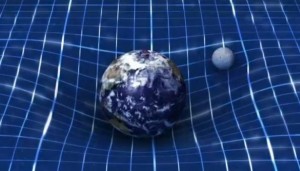
A visual demonstration of how and why the moon revolves around the Earth: it's like the Earth is making an indentation in space and the moon is rolling around the periphery of the indentation -- or something like that. Do you understand now?
One of the latest science program offerings, now available on DVD, is PBS’s NOVA Science series (See Footnote 1), called The Fabric of the Cosmos; based on the book– and hosted– by Brian Greene. I was eager to have my mind blown. But two minutes into it, I thought, “I didn’t realize that this was aimed so heavily at youngsters.” How young was not quite clear, but the proliferation of fun graphics and animation seemed to get in the way of pure documentary presentation. Then from minute 3 forward, frustration set in when I had trouble grasping what Brian Greene was talking about (feeling doubly stupid because the demographic seemed aimed at kids). Soon it occurred to me that this was too complex for the average young person but had too many “cool” graphics for adults. Then ultimately I realized that the program is for mathematicians and others who are already familiar with the material covered. As a primer for people like me, learning about the stuff for the very first time, it’s a lost cause, and all the fun graphics and cool animation in the world won’t make up for being left in the dust.
Disc one asks “What Is Space?” Not just outer space, but all space, including empty space. It’s still hard to grasp the concept that atoms are mostly empty space, and that if all of the empty space in the Empire State Building were removed, what would remain as purely and absolutely solid matter would be about the size of a grain of rice (albeit one that weighed millions of pounds). If the scientific community agrees on it, then who am I to say they’re wrong? But there’s believing it – or having faith that the scientists are correct – and then there’s understanding it. I simply cannot wrap my head around the thought that rice grain-sized solid matter can be stretched out to the size of the Empire State Building (even though I love the thought of something as small as a grain of rice weighing hundreds of millions of pounds). It’s not enough to just tell me that atoms are mostly empty space. (Though in her not-quite-scientific book Going Within, Shirley MacLaine seizes on the idea that matter is mostly empty space to explain how a mystic surgeon was able to put his hand through her body to remove a cancer.)
It’s also tough squaring the idea that we actually live in a two-dimensional world, and that our experience of living in three dimensions is the result of being a sort of hologram that’s projected from this two dimensional source. This is not a proven fact, but is nonetheless a concept that scientists say might be true. Like most of the science discussed, this series serves to merely introduce the idea, not to shed any light on how it might be so.
Disc 2 is “The Illusion of Time.” Are you ready for the idea that past, present, and future all exist at the same time? That time changes and bends relative to the position one person is to other people or objects? That, in fact, time itself is a dimension of space? Brian Greene throws out these incomprehensible ideas, and then confidently goes about explaining them, as if to bright 8-year-olds who will quickly comprehend the meaning and exclaim, “That’s awesome!” But if you haven’t already studied this beforehand, good luck; The Fabric of the Cosmos is cold comfort to anyone who wants to not just know but also understand. The graphics and animation are superb illustrations of the words he’s saying, but they tend to be more distracting than helpful. The visuals are extremely busy, which doesn’t facilitate absorbing brand new, complex ideas. It’s like trying to listen to a whisper while surrounded by bells and whistles.
Disc 3, “Quantum Leap,” which is an introduction to Quantum Mechanics, was equally baffling at first, but, unlike Space and Time, with enough backtracking and re-listening to the information over and over, a lot of it began to make sense’¦if only barely. But even when you learn how the laws of entropy dictate that it’s mathematically sound that, if velocities were reverse, everything could happen backwards as well as forwards (a glass could un-break, for example), you have to ask if it’s nothing more than a mathematical oddity that has no functional purpose when applied to real life circumstances. (Even Einstein, we’re told, refused to believe one theory of Quantum Mechanics as anything more than “mathematical tricks.”)
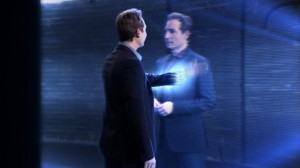
Brian Greene confronts his hologrammatic self; so now do you get how the three dimensions of our reality are, in reality, a two-dimensional hologram projection (maybe)?
I personally found disc 4, “Universe or Multiverse?,” the easiest to grasp as a snapshot (though, to be sure, the scientific theories behind it continued to make my head spin), and, ironically, it is the one episode that is almost entirely speculation and best guesses rather than hard, provable science. The basic premise began as a solution to one of the mysteries of the Big Bang: if the universe as we know it began with the Big Bang (and science generally accepts that it did), then what was here before it? How could everything that exists come out of nothing? Well, it makes much more sense if our universe is actually one out of many universes. That is to say that, beyond the solar system, beyond galaxies, beyond novae and supernovae, and beyond everything we can imagine is out there, perhaps there are other universes that had their own big bangs, and we are actually part of a system of universes – or, rather, a multiverse. The argument that the very term “The Universe” implies everything that exists everywhere, knowable and unknowable, everything we can imagine and everything beyond what we can imagine, is acknowledged; so one must make the adjustment to redefine “The Universe” as “Our Universe” – i.e., the one born out of our own big bang, while several “Other Universes” had (and are having, and will have) their own big bangs. However, there is not, ahem, universal agreement on this in the scientific community. Brian Greene even asks at one point, “Should you believe it?” (See Footnote 2)
While watching the series, the question constantly comes to mind: am I not smart enough to understand this, or are they not explaining it well? Or, perhaps, each of the four episodes – space, time, quantum physics, and multiverses – are simply too complex to simplify each subject within an hour’s time. I mean, is it really a reasonable complaint that you weren’t able to grasp Einstein’s ideas in four one-hour television episodes? (Einstein is practically the star of the show, next to Brian Greene.) I personally felt relieved when I met someone tons smarter than myself, and whose father teaches science, who also felt unenlightened by the series.
Brian Greene is a good host, personable and inviting (and I suspect that his book is an infinitely less frustrating experience). But, dammit, he does not want to give up his position as a science expert. Thus, as the program cuts away to various science experts on hand, one of the experts who regularly makes an appearance is ’¦ Brian Greene?! It is so jarring to see the Host play One Of The Experts Being Interviewed that it’s inconsequential whether what he says as a science expert is comprehensible or not – you’re too busy thinking, “Hey, it’s Brian Greene, the Host of the show, as One Of The Experts Being Interviewed!” (This disorienting element never lets up, and I watched the whole series twice.)
So if you’re about to take a college course on these subjects, The Fabric of the Cosmos might be a great way to get your brain wet. Just don’t expect to understand anything. But you might take some comfort that even the science experts themselves don’t understand everything covered in the series. As one of the (non-Brian-Greene) experts says, “Don’t ask me how it works, because it’s an illegal question. All we can say is, that is apparently the way the world ticks.”
The Fabric of the Cosmos
hosted by Brian Greene
based on the book The Fabric of the Cosmos by Brian Greene
executive editor Brian Greene
PBS Distribution
approximately 4 hours on 2 discs
DVD $29.99 / Blu-ray $34.99
for more information and to see equally incomprehensible links of elaboration, visit http://www.pbs.org/wgbh/nova/physics/fabric-of-cosmos.html (where the purchase rate is: DVD $19.99 / Blu-ray $24.99)
Footnote 1. The NOVA Science series is part of PBS – meaning that it is something the right wing does not want you to see. Science? Education? Phooey! Too many facts; too much knowledge. As such, it is disorienting to see major contributor David H. Koch’s name prominently displayed at the beginning and end of every episode. Is it a ploy to make liberals associate his name with something positive; or is it perhaps a way to deter them from watching anything science- and education-related? This is, after all, the billionaire supporting the Tea Party candidates, and yet the series bluntly acknowledges that the Universe as we know it has been around for 14 billion years – that’s a hell of a lot more than the mere 6,000 years popularly calculated in the Bible. Do the anti-evolutionists he supports know how two-faced he’s being? (back to review/commentary)
Footnote 2. True or not, I like the theory very much. As visualized by the NOVA graphics and animation department, our universe is like a cell in a huge complex of cells. And although it’s not mentioned in this way, it actually makes it a little easier to understand the concept of atoms being comprised primarily of empty space. If our entire universe – the one born of “our” big bang – is, say, equivalent to an atom in a larger structure of infinite additional universes (wherein it’s simpler to visualize the vast amounts of empty space between the stars and galaxies), then, thinking of an atom on this scale, it’s a little easier to imagine how the Empire State Building could be reduced to the size of a grain of rice with all the empty space removed. Also not mentioned – and again, this is just my own speculation – is that if our entire universe is the equivalent of an atom in an even larger world, then it should be theoretically true in the other direction; that is, each of our earthbound atoms contain their own tiny universes inside them. Each atom, then, would have had its own big bang when it sprang into existence, and everything, our bodies included, contains billions and trillions of universes with their own space-time continuums. Just a thought. (back to review/commentary )
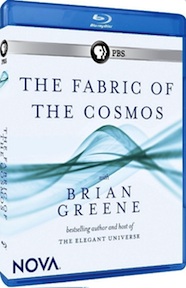
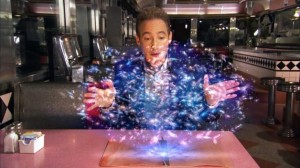
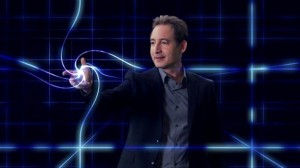

{ 3 comments… read them below or add one }
John Topping is the finest reporter & writer in our Universe.
My mother, folks. She can’t help it.
I disagree with this review, read my take at http://physics.about.com/b/2011/12/11/fabriccosmos-2.htm